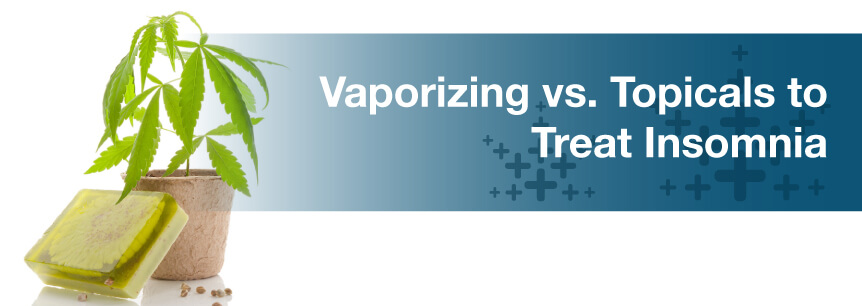
Medical marijuana has been shown to work as a sleep aid for patients with insomnia. Its flexibility and lack of dangerous side effects provide relief when traditional sleep medicine won’t. But, with this versatility also comes many options for patients to navigate, including product choice. Two potential product choices for insomnia patients are vaporizing products and topical treatments.
Vaporizing, or vaping, acts as an alternative to smoking medical cannabis. While smoking marijuana has fewer risks than smoking tobacco, the smoke can still cause lung irritation for some patients. Instead of burning the medicine, vaporizing uses heat and water to create a vapor for the user to breathe in.
Topical treatments are medications you apply to your skin instead of inhaling or ingesting them. They include patches, creams, balms and more. Most patients use topicals for localized muscle pain and inflammation, but you can also use them for relaxation or sleep. You can apply a soothing cream to your temples or back of your neck or use a patch.
Inhaling cannabis lets you experience nearly immediate relief, and vaping avoids the side effects of smoking. So, vaporizing provides fast benefits without harming your lungs. While many medical marijuana states ban smoking, the same states often approve vaping, making it accessible to people all over the country. You can find vaping products and equipment easily. Not only do many dispensaries carry them, but you can also get vaporizers at tobacco shops.
However, you have to put in extra money and effort to vape safely. Certain kinds of vaporizers can char the medication, causing similar risks to smoking. You must know how to vape properly to avoid burning, and investing in a more expensive vaporizing unit further reduces the risk. There are many kinds of units out there, and you need to know how to use yours correctly.
Topicals provide fast, pinpointed effects for patients with a multitude of symptoms. Since cannabis dissolves into fatty substances, marijuana lotions and creams quickly absorb into your skin. Patients who need extended relief can use a patch, which delivers medicine right into the bloodstream. If you don’t mind putting in the extra effort, you can make your own topicals out of bud or oil.
But, due to topicals’ localized nature, they may not offer enough strength for patients who only need help with sleep. Lotions and creams have to pass through the skin to get into your system, and patches provide a buildup effect over time. If you have allergies, you may have a reaction to products with extra ingredients.
Before making a decision, check your state’s medical marijuana laws to see if these product types are permitted. Some states also have different possession limits for different kinds of products.
Ultimately, the best product choice will depend upon the patient’s symptoms, abilities and lifestyle. Vaporizing and topicals have their own strengths that can suit your sleep needs — for example, if you need to stay asleep at night, you can take advantage of a patch’s continuous relief. If you need help falling asleep, you can vape to promote relaxation before bed.
Your other symptoms should come into play, too. If you have difficulty sleeping due to aches and pains, you can use a topical to get better rest and pain relief at the same time. At the same time, people who have health issues related to the nervous system might get more multi-symptom relief out of vaporizing than a topical.
Need more help deciding? Booking an appointment with a marijuana-friendly doctor lets you get personalized advice. The staff at a dispensary can also assist you with making the right purchase.